Hungarian braised chicken with smoked paprika in a sour cream sauce is served over homemade dumplings.
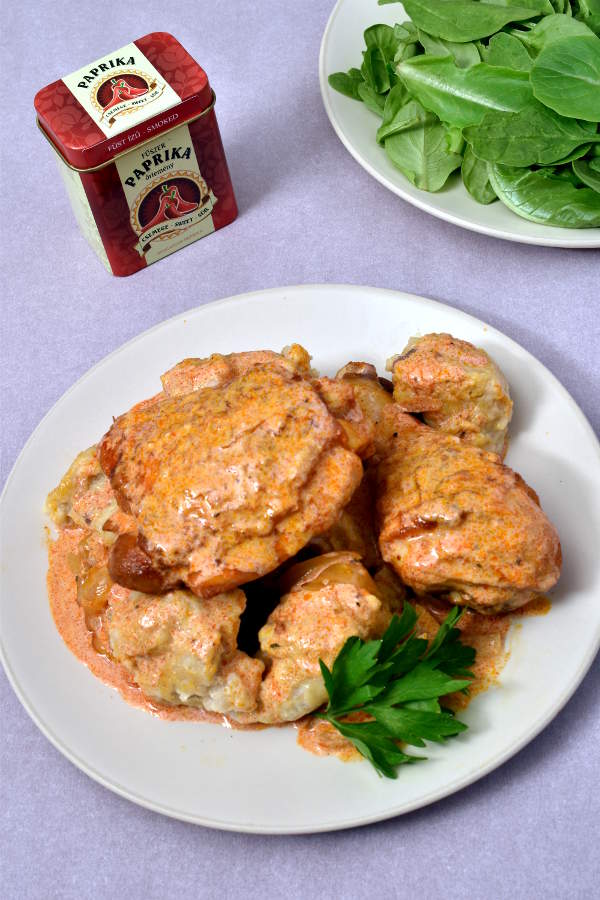
Picture the scene. It’s a summer night in Budapest, the Paris of the East. Smells much better than actual Paris. Temperature in the low 80’s. You’re sitting in the enclosed dining room of a boat, on your Danube dinner cruise. From the windows, you can see the bridges all lit up. There’s no air conditioning in the room, and it’s humid. You feel that Hungarian Bull’s Blood wine warming you up even more, and you’re wiping sweat off your forehead with a dinner napkin. What do you want to eat now?
Piping hot stewed chicken over dumplings?
Well, I was only in Budapest once. That’s what they were serving. Despite it being salad weather, I wasn’t going to pass up eating paprikash in Hungary.
It was delicious, and I don’t regret it.
During desert, a seven layer cake called a Dobos torte, we passed the Parliament building. I ran upstairs to the open part of the boat to take a picture. The way the building was lit up, it looked golden and glowing against the dark night sky. There were birds circling over the roof. The lighting made the birds look gold too. Here’s the picture:

When I went back to the dining area to finish my cake, they had already cleared my plate.
Oh well. You can’t win them all.
Let’s talk about this dish. Is it chicken paprikas or chicken paprikash? My spell check doesn’t like either one. I learned that in Hungarian, the letters sz make a regular s sound, but the letter s by itself makes a sh sound. (I am kind of a nerd about language and was quite fascinated.) So you pronounce the name of the city Budapest like Budapesht. The dish is spelled paprikás in Hungarian, but most spellings I’ve seen in English are paprikash to reflect the pronunciation.
I wanted to make my own chicken paprikash for Jonathan once I came home. It’s really a hearty winter comfort food, so I waited until our first bout of cold weather. I’ve made this several times since then because we both enjoyed it.
Paprika is a spice made out of ground dried peppers. In Hungarian cuisine, I’ve seen four varieties, sweet and spicy and a smoked version of each. We don’t like spicy food, so I used smoked sweet paprika in this recipe. I bought some at the Market Hall in Budapest to take home, but that supply is long gone. I’ve been warned that paprika loses its flavor after just a few months, so you need to buy it often and in small quantities that you can use up before it goes bad. Don’t use that three year old jar from the back of your cabinet.
This chicken paprikash would be good over egg noodles, rice or boiled potatoes. (If you’re carb conscious, I’d suggest cauliflower rice so at least you have something to soak up the sauce.) I think it’s best, however, with homemade dumplings, called nokedli in Hungary, and also known as spätzle. These dumplings are common in many Eastern European cuisines.
I shared a recipe for Polish dumplings called kopytka with this pork tenderloin recipe. Those were potato dumplings, while these are made only with wheat. While the Polish potato dumplings are delicious, these are much easier to make. There are no potatoes to cook and no need to roll out dough. You just mix everything in one bowl and spoon it directly into a pot of boiling water. You can easily make the dumplings during the inactive cooking time for the chicken. I did make my dumplings larger than the traditional nokedli to make things a little easier, and I used half white whole wheat flour.
Here are the main ingredients. You can use any mix of dark or white meat chicken that your household prefers. I used two breasts, four thighs, and two drumsticks. If you use breasts, cut them in half so they don’t take too long to cook.
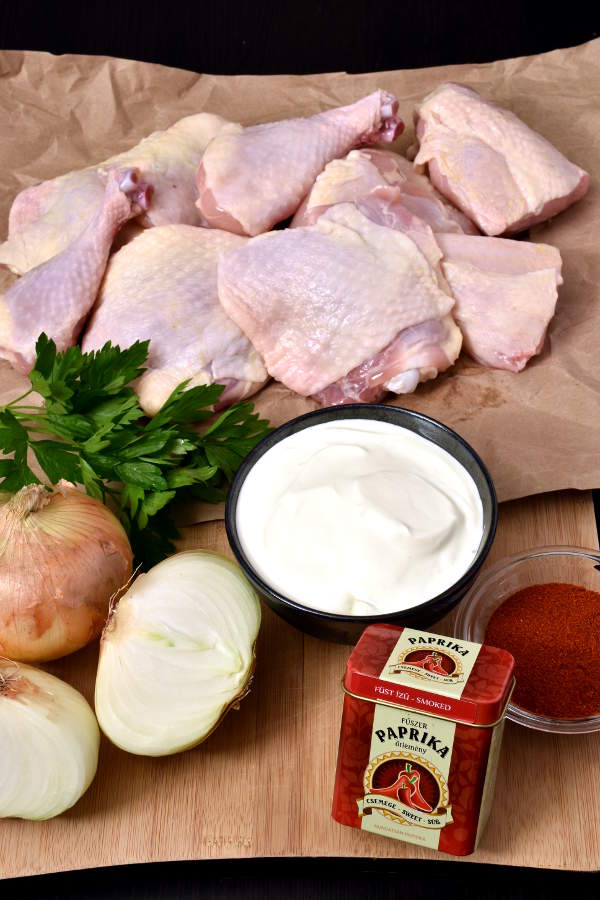
To start off, I browned the chicken in two batches. Here’s half of my chicken:
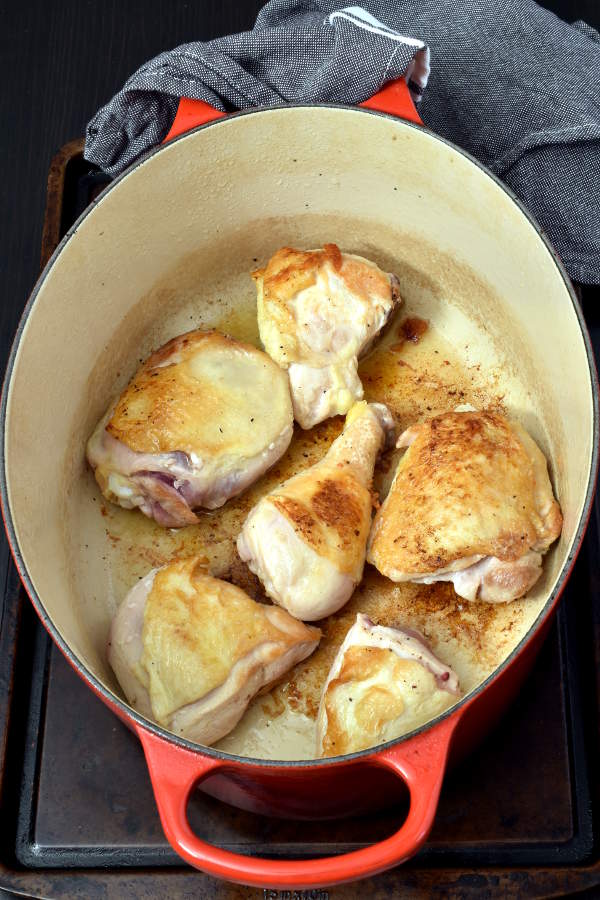
Later on, I made the dumplings while the chicken was cooking. The dumplings are made with flour, white whole wheat flour, salt, eggs, and sour cream.
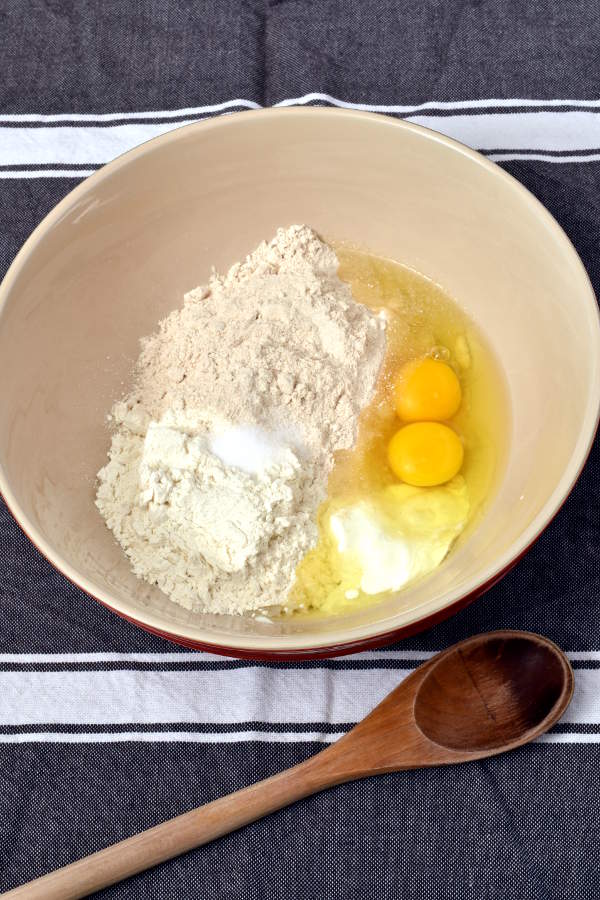
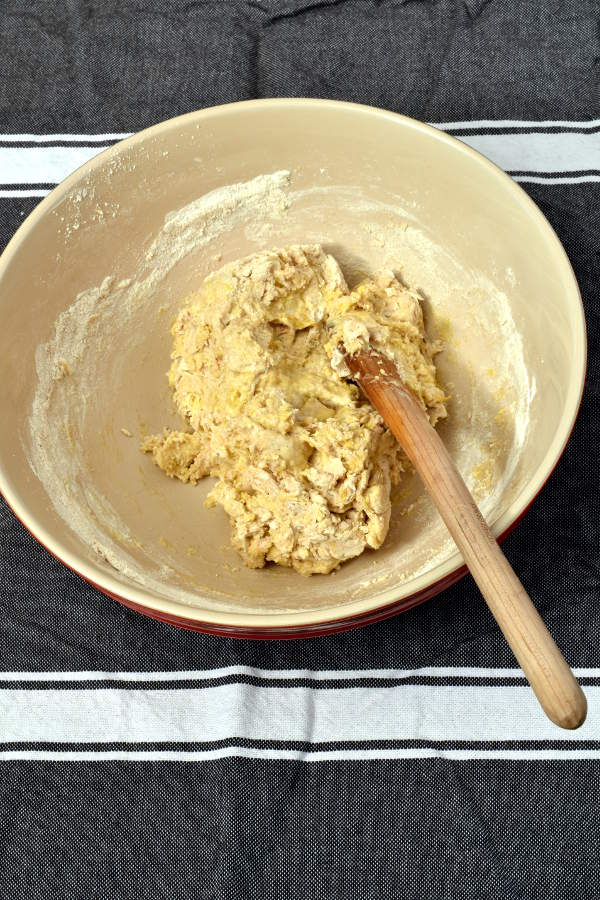
Here are the cooked dumplings. Toss them with some melted butter, and they’re delicious on their own.
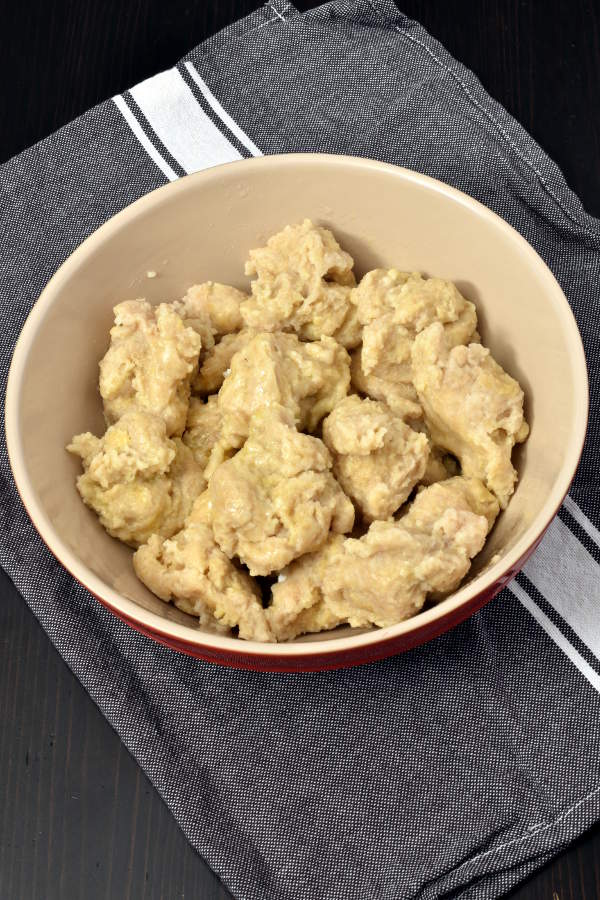
Here’s the chicken that’s finished cooking. You’ll remove the chicken pieces and mix the sour cream into the sauce once it’s cooled down a little.
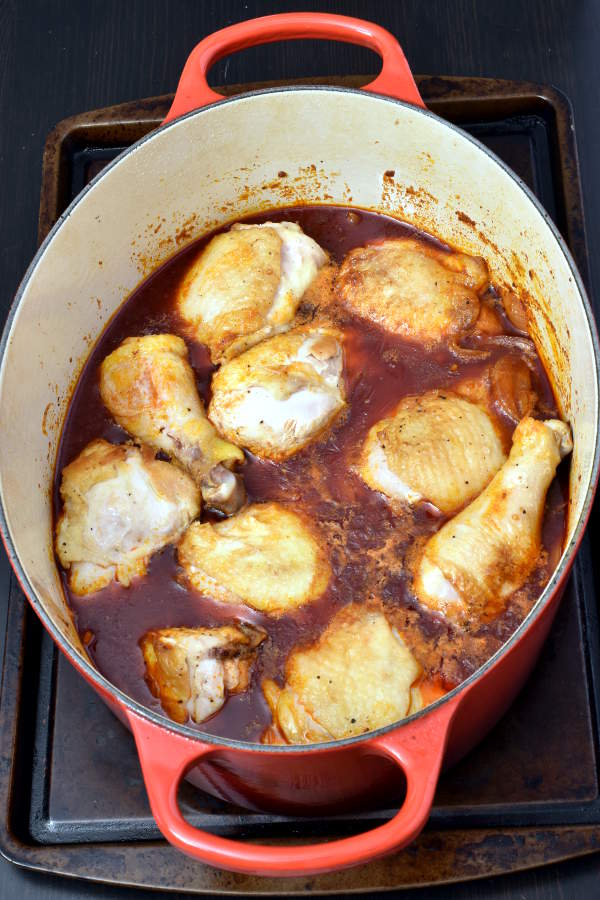
Guys, it’s not easy photographing something smothered in orange sauce. Don’t discriminate against this recipe because of my poor photography skills. My pictures are just not doing it justice. If you like creamy saucy chicken, you must give this one a try!
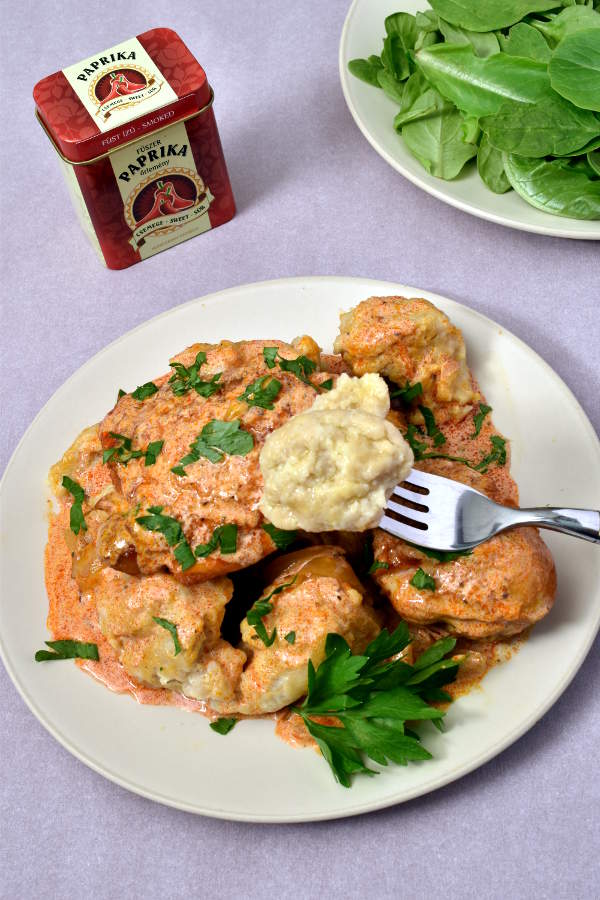
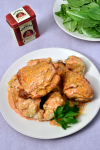
Chicken Paprikash with Dumplings
Ingredients
Chicken Paprikash
- 3 1/2 - 4 pounds skin-on bone-in chicken pieces (if using breasts, cut in half)
- salt and pepper
- 1 tablespoon grapeseed or canola oil
- 1 tablespoon butter
- 2 sweet onions, thinly sliced
- 3 tablespoons sweet smoked paprika
- 1 tablespoon flour
- 1 1/2 cups low sodium chicken broth
- 1 1/3 cup sour cream
- chopped parsley for garnish (optional)
Dumplings
- 1 cup flour
- 1 cup white whole wheat flour
- 1/2 teaspoon salt
- 2 large eggs
- 2 tablespoons sour cream
- 2 tablespoons butter, divided
Instructions
Chicken Paprikash
- Season chicken with salt and pepper. In a large Dutch oven, heat oil over medium-high heat. Cook chicken, skin side down, until the skin gets a nice golden brown, 4-5 minutes. Turn chicken over and cook 3-4 minutes on the other side, until browned. If your chicken doesn’t fit on the bottom of your pot in a single layer, brown in 2 batches. When you’re done, remove chicken from pot and set aside.
- Reduce heat to medium. Melt 1 tablespoon butter in the pot with the chicken fat. Add onions to the pot and season with salt and pepper. Cook, stirring occasionally, until onions are soft, about 10 minutes.
- Remove pot from heat. Add paprika and 1 tablespoon flour and stir to coat the onions. Pour in chicken broth and scrape up the browned bits at the bottom of the pan. Place the chicken pieces on top of the onions, skin side up.
- Cover and bring to a boil over high heat. Once boiling, lower the heat to medium low and simmer for 30 minutes, until chicken reaches an internal temperature of 165 degrees. While the chicken is cooking, make the dumplings (see instructions below).
- When chicken is done, remove from heat. Take the chicken pieces out of the pot. This is important: WAIT 10 minutes or so until the pot cools down a little. (I know you’re hungry. Snack on a dumpling.) Then mix the sour cream into the sauce. If you add the sour cream when the sauce is too hot, it might curdle on you. (It will still be edible and quite tasty, but it won’t have that smooth velvety texture.)
- To serve: Divide dumplings between serving plates or bowls. Place chicken pieces over the dumplings. Spoon the sauce (with onions) over each serving. Garnish with parsley if desired.
Dumplings
- Bring a large pot of salted water to a boil over high heat.
- Add flour, white whole wheat flour, salt, eggs, 2 tablespoons sour cream, and ½ cup water to a large mixing bowl. Stir to combine, breaking up the eggs as you stir. You should end up with a thick sticky dough. If the dough is too dry and not holding together, add 1 more tablespoon water.
- Place a small bowl of cold water on your counter. Drop 1 small spoonful of dough at a time into the boiling water. Dip the spoon into the cold water after each dumpling to prevent the spoon from sticking to the dough on the next one. You can make the dumplings smaller or larger, according to your preference or patience. The bigger your dumplings, the faster you’ll get through the dough.
- I recommend cooking the dumplings in 2 batches. When you’ve used about half your dough, wait for the majority of the dumplings to float to the top. If you made them on the smaller side, cook for 3 more minutes. If you made them on the larger side, go for 4-5 more minutes. Once done, use a slotted spoon to fish out the dumplings and put them in a bowl. Add 1 tablespoon butter to the dumplings and mix a little so the butter melts. The melted butter will keep them from sticking to each other. Cover the bowl with a pot lid to keep them warm while you make the second half of the dumplings. When those are finished, add to the bowl with the second tablespoon butter.
Bon Appétit!
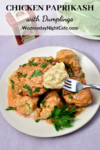
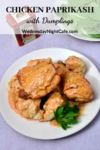
Leave a Reply